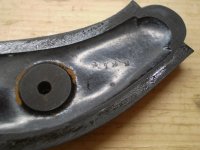- Joined
- Sep 3, 2016
- Messages
- 4
- Reaction score
- 0
WHAT ARE THE REQUIRED SERIAL # LOCATIONS. ARE THERE SERIAL NUMBERS ON THE HARD RUBBER GRIPS.
MY DAD AND I TRADED FOR THIS FINE + REVOLVER SN#864X IN THE MID 60'S IN WICHITA KS. IT IS MATCHING #'S ON THE BOTTOM GRIP, BACK OF CYLINDER, UNDER THE LATCH. RECENTLY LOOKING ON LINE I SEE REFERENCE TO SN#'S INSIDE THE RIGHT GRIP. IS THIS A REQUIRED FACTORY LOCATION ON EVERY FACTORY GUN?? THE LAST TIME THIS REVOLVER WAS APART WAS MID 90'S AND THE GRIP HAS NO #.
IF I DECIDE TO SELL IT WILL THIS AFFECT VALUE. I WOULD SWEAR THE GRIPS ARE ORIGINAL TO THE GUN.
MY DAD AND I TRADED FOR THIS FINE + REVOLVER SN#864X IN THE MID 60'S IN WICHITA KS. IT IS MATCHING #'S ON THE BOTTOM GRIP, BACK OF CYLINDER, UNDER THE LATCH. RECENTLY LOOKING ON LINE I SEE REFERENCE TO SN#'S INSIDE THE RIGHT GRIP. IS THIS A REQUIRED FACTORY LOCATION ON EVERY FACTORY GUN?? THE LAST TIME THIS REVOLVER WAS APART WAS MID 90'S AND THE GRIP HAS NO #.
IF I DECIDE TO SELL IT WILL THIS AFFECT VALUE. I WOULD SWEAR THE GRIPS ARE ORIGINAL TO THE GUN.

